
 |
|
M —
D O C S: M I S C E L L
A N E O U S D O C U M
E N T S |
|
thru 1927 |
1928 |
1929 |
1930 |
1931 |
1932 |
1933 + |
|
1
|
2
|
3
|
4
|
5
|
6
|
7
|
8
|
9
|
10
|
11
|
12
|
1
2
3
4
5
6
7
8 9
10 |
1
2
3
4
5
6 |
7
8
9
10
11
12 |
1 2 3 4 5 6 |
7 8 9 10 11 12 |
1 2 3 4 5 6 |
7 8 9 10 11 12 |
1 2 3 4 5 6 |
7 8 9 10 11 12 |
1 2 3 4 5 6 |
7 8 9 10 11 12 |
1 2
3 4 5 6
7 8 9 10 |
|
THIS IS THE EIGHTH
PAGE
of the M-DOCS (Miscellaneous Documents) pages,
covering the month of
October 1927. The page
is in progress.
This website project is
indebted to Mr. Brandon Ray, Summa Cum Laude
college graduate from Ashford University in Iowa
(with a B.A. in History and a minor in Political
Science) for his meticulous transcriptions on
this and many other pages.
|
|
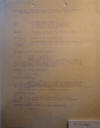
|
1.
October 1, 1927.
"Intelligence Report for the week ending October
1, 1927," Major Glenn E. Hayes, C.O. Ocotal, to
Chief of the G.N., Managua, p. 1.
"Headquarters, Division of Nueva Segovia,
Guardia Nacional de Nicaragua, Ocotal,
Nicaragua, October 1, 1927. ¶ From: The
Commanding Officer. ¶ To: The Chief of Guardia
Nacional de Nicaragua, Managua, Nicaragua. ¶
Via: OFFICIAL CHANNELS. ¶ Subject: Intelligence
report for the week ending October 1, 1927. ¶
Reference: Paragraph 15, Special Order # 60. ¶
1. In accordance with the provisions of the
reference, I report as follows for the week
ending October 1, 1927: ¶ GENERAL STATE OF
TERRITORY OCCUPIED: ¶ (a) Ocotal – peaceful. ¶
(b) Jicaro – peaceful. ¶ (c) Intervening
territory – generally peaceful but inhabitants
are nervous and easily excited. They appear to
expect some enemy action in the near future. I
believe this to be solely conjecture on their
part. ¶ ATTITUDE OF CIVIL POPULATION: ¶ (a) No
change ¶ ECONOMIC CONDITIONS: ¶ (a) Ocotal –
very good – prices of all commodities are coming
down. Sugar, which was $20. per hundred pounds
when the 1st Company arrived at Ocotal, now
costs but $12. for that amount ¶ (b) No noted
change in other districts. ¶ ATTITUDE OF PRESS:
¶ (a) No periodicals published in Division. ¶
(b) No reports received on attitude of foreign
press. ¶ FRICTION BETWEEN TROOPS AND CIVIL
POPULATION: ¶ (a) None. [...]"
|
|
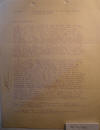
|
2.
October 1, 1927.
"Intelligence Report for the week ending October
1, 1927," Major Glenn E. Hayes, C.O. Ocotal, to
Chief of the G.N., Managua, p. 2.
"[...] Subject: Intelligence report for the week
ending October 1, 1927. ¶ POLICE OPERATIONS: ¶
(a) Fernando Vallecillo shot himself twice in
the chest on the public street at 7:30 PM,
September 27, 1927. He died about five minutes
later as a result of those wounds. No persons
actually witnessed this incident but the fact
that he had been in a state of melancholia
during the day together with the fact that
neither his outer nor his under shirt was
pierced by the bullets points directly to
suicide. The pistol connected with this incident
was a 32 calibre Smith and Wesson and was found
close to the body. It contained two exploded
cartridges the other chambers being empty. This
pistol was purchased from Guillermo Lopez by
Vallecillo on September 26th. The latter stated
to Lopez that he intended to secure the regular
permit for the possesion [possession] of
firearms that same day. This office has no
record of an application for a permit to possess
or carry firearms by him. ¶ (b) A gang murder
was reported to have taken place at Los Arados,
one league north of Monsonte, on the afternoon
of September 29th. Dispatched a patrol under the
command of Captain Grover C. Darnall, Guardia
Nacional, to that vicinity early in the morning
of September 30. This patrol, apparently, had an
unreliable guide as it later developed that he
did not take them to the place in question but
about one mile short of that place. This patrol
returned at noon of the same day reporting that
the inhabitants had heard of no bandit activity.
I dispatched another patrol to that place the
following morning and this patrol developed the
fact that Geroncio Florian was killed at Los
Arados as reported. He was, according to the
reports of civilians, set upon by an armed band
who fired at him and inflicted a slight scalp
wound. He was then attacked with machetes and
killed. One man fled from the patrol upon its
approach but his horse was captured. Agepito
Amaya has been apprehended in connection with
this murder but the principal participants are
still at large. The following named men,
described by eyewitnesses to have actually
killed Florian, are wanted by these
headquarters: ¶ Gerardo Lopez – residence
Monsonte – medium build – dark – slightly
bearded – curly hair – has elephanthiasis
[elephantiasis] of one foot – a known killer ¶
Eulalio Gomez – residence Monsonte – thin – tall
– smooth shaven – dark – straight black hair.
[...]"
|
|
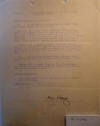
|
3.
October 1, 1927.
"Intelligence Report for the week ending October
1, 1927," Major Glenn E. Hayes, C.O. Ocotal, to
Chief of the G.N., Managua, p. 3.
"[...] Subject: Intelligence report for the week
ending October 1, 1927. ¶ POLICE OPERATIONS,
(continued): ¶ (c) The following named men were
confined during the period covered by this
report: ¶ September 27, Ramiro Ortez, residence
ORISI Rancho, father Presentacion Ortez with
same address. This young man is apparently
violently insane but has intervals of apparently
rational mentality. He was confined and
otherwise restrained as a protection to himself
and to others. A letter to the Chief of Guardia
has covered this case. ¶ September 28, Francisco
Salcedo, residence Ocotal. This man is charged
with calumnia by one Fernando Jarquin growing
out of certain public statements he is alleged
to have made in connection with the death of
Fernando Vallecillo. ¶ (d) The following
prisoners were released during the period
covered by this report for the reasons
indicated: ¶ October 1st. Francisco Salcedo.
Upon the execution of a fianza by a properly
qualified citizen guaranteeing his appearance
when desired. ¶ MILITARY OPERATIONS: ¶ (a) None
other than the military patrols reported in
police operations. ¶ Miscellaneous: ¶ (a) None.
¶ Glenn E. Hayes."
|
|
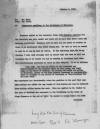
|
1.
October 1, 1927.
"Chamorro's candidacy to the Presidency of
Nicaragua," memo from Mr. Francis White to Mr.
Robert Olds, p. 1.
"October 1, 1927. ¶ To: Mr. Olds. ¶ From: Mr.
White. ¶ Re: Chamorro’s candidacy to the
Presidency of Nicaragua. ¶ Chamorro called on
the Secretary today with Chandler Anderson but
the Secretary was very rushed and could not do
more than shake hands and exchange civilities.
Chamorro will be here all the month of October
so there is no particular rush about seeing him.
He told me that he wanted to come in to see me
upon my return. If the Secretary sees him in any
absence, I feel very strongly that we should
tell him that we will not recognize him if he
should run and be elected as President next
time. The Constitutional provision is clear on
this subject. It is as follows: ¶ “Art. 104. The
term of office of the President and
Vice-President of the Republic shall be four
years, and shall begin on the first of January.
No citizen who holds the office of President,
either as the duly elected incumbent or
accidentally, shall be eligible to the office of
President or Vice-President for the next term.”
¶ The Department has consistently taken the
position in the past that anybody holding the
office for any length of time during one term is
debarred from holding office during the next.
This was applied by Mr. Hughes in the case of
Martinez who succeeded to the Presidency on the
death of Diego Chamorro at the end of 1923. He
wanted to resign before the 1924 ¶ elections
[…]"
|
|
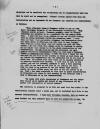
|
2.
October 1, 1927.
"Chamorro's candidacy to the Presidency of
Nicaragua," memo from Mr. Francis White to Mr.
Robert Olds, p. 2.
"[…] elections and be candidate for re-election
and we categorically told him that he would not
be recognized. Colonel Stimson agrees with this
interpretation and on September 26 saw Chamorro
and reported his conversation as follows: ¶
“This afternoon General Chamorro called to see
me with Major Rodriguez formerly of the
Nicaraguan Constabulary. They remained nearly an
hour. Chamorro promptly asked me whether
everybody was eligible to be a candidate for the
coming election. I told him that in my opinion
he was not eligible having been an acting
president during the preceding term. I also told
him that I had personally witnessed the
devastation which had taken place in Nicaragua
and felt that it very largely came from his
action under very bad advice and that for this
reason I did not think that anyone would be
inclined to modify on his behalf what seemed to
be the plain construction of the Constitution.
He said that he was the strongest and most
popular man in the Conservative Party and that
such a decision tended to handicap that Party. I
told him that I hoped for his own sake and for
that of his country he would go back there and
get behind the Conservative who was nominated
and do his best to elect him. He replied that
this would not be equally effective in securing
Conservative success. I said that we were in the
country now and had solemnly promised to hold a
fair election and would do our best to see that
it was orderly and fair. I told him that in my
opinion it was far better that America should
not favor either party and that we did not
intend to do so. That I had been surprised to
find that as great manifestation of friendship
was shown to this country by the Liberals when I
went to Nicaragua as by the Conservatives. ¶ “He
spoke with every appearance of frankness and the
interview though plain spoken was devoid of any
bitterness and we parted with expressions of
mutual esteem.” ¶ The Secretary is prepared to
do this and went into the matter of the
Constitution himself about a month ago, and is
satisfied that this is the correct
interpretation. I feel very strongly, however,
that we should go even further and tell Chamorro
that we will not permit him to run. He ¶ was
[…]"
|
|
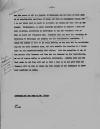
|
3.
October 1, 1927.
"Chamorro's candidacy to the Presidency of
Nicaragua," memo from Mr. Francis White to Mr.
Robert Olds, p. 3.
"[…] was the cause of all the trouble in
Nicaragua and now that we have gone in at
considerable sacrifice of money and life to
straighten things out I do not think that we
would be justified in seeing all this work go
for naught. Furthermore, we would stultify
ourselves to conduct a free and fair election,
permitting an individual to run for President
when we knew we would not recognize him.
Chamorro will say that the Secretary is
dictating to Nicaragua and picking out its
Presidential candidate. I think the answer is
that he is doing nothing of the sort but is
straightening out the mess Chamorro made, and
that entails the election of a President who can
constitutionally hold office. With the exception
of one or two persons like Chamorro and Diaz who
are debarred by the Constitution, we are of
course making no exceptions whatsoever. Anybody
else can run that wants to and they will get as
fair a deal as we can give them and Chamorro
will be free to throw the full weight of his
influence to whatever candidate he wants. ¶
Dictated but not seen by Mr. White. ¶ A-L ¶
FW:ABN"
|
|
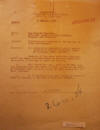
|
October 7, 1927. "Violations of
Instructoins for the Use of Codes and Ciphers,"
Brigade Commander L. M. Gulick, Managua, to
Commander Special Service Squadron Flagship USS
Rochester.
HEADQUARTERS, ¶ SECOND BRIGADE MARINE CORPS, ¶
MANAGUA, NICARAGUA. ¶ 7 October, 1927. ¶ SECRET
¶ From: The Brigade Commander. ¶ To: Commander
Special Service Squadron, Flagship USS
ROCHESTER. ¶ Subject: Violations of Instructions
for the Use of Codes and Ciphers. ¶ Reference:
(a) Letter from Commander Special Service
Squadron to Brigade Commander, dated 24
September 1927, A6-3(304). ¶ 1. Contents of the
above reference have been noted and steps have
been taken to prevent further discrepancies in
the use of codes and ciphers. ¶ 2. This office
has not a copy of C&P 457, same was requested
from the Chief of Naval Operations by radio, 3
September 1927, to date a reply to this request
has not been received. ¶ 3. It is requested that
this office be furnished with all changes in the
use of codes and ciphers. ¶ L. M. GULICK."
|
|
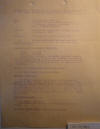
|
1.
October 8, 1927.
"Intelligence Report for the week ending October
8, 1927," Commanding Officer Glenn E. Hayes,
Ocotal, to Chief of the G.N.N., Managua, p. 1.
"Headquarters,
Division of Nueva Segovia, Guardia Nacional de
Nicaragua, Ocotal, Nicaragua, October 8, 1927. ¶
From: The Commanding Officer. ¶ To: The Chief of
the Guardia Nacional de Nicaragua, Managua,
Nicaragua. ¶ Via: OFFICIAL CHANNELS. ¶ Subject:
Intelligence report for the week ending October
8, 1927. ¶ Reference: Paragraph 15, Special
Order # 60. ¶ 1. In accordance with the
provisions of the reference, I report as follows
for the week ending October 8, 1927: ¶ GENERAL
STATE OF TERRITORY OCCUPIED: ¶ Ocotal – peaceful
¶ Jicaro – peaceful ¶ Intervening territory –
generally peaceful. Bandits are reported,
however, to be in the vicinity of La Puerta
which endangers the line of communication
between this city and Jicaro should they plan to
move in the direction of Santa Clara ¶ Attitude
of Civil Population Toward Forces: ¶ No noted
change in area occupied. ¶ ECONOMIC CONDITIONS:
¶ No change in conditions reported in my report
of October 1, 1927. Prices fluctuate in the
matter of foodstuffs, but this is believed to be
normal considering the infrequency of pack
trains due to inclement weather. Labor is
plentiful and employment is available provided
men are willing to leave the cities and work in
haciendas. Most of them, however, prefer to
remain in the cities where troops are present. ¶
ATTITUDE OF PRESS: ¶ No press in division. ¶ No
information received as to attitude of foreign
press. ¶ FRICTION BETWEEN TROOPS AND CIVIL
POPULATION: ¶ None. [...]"
|
|
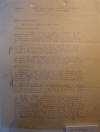
|
2.
October 8, 1927.
"Intelligence Report for the week ending October
8, 1927," Commanding Officer Glenn E. Hayes,
Ocotal, to Chief of the G.N.N., Managua, p. 2.
"[...] Subject:
Intelligence report for the week ending October
8, 1927, (continued). ¶ POLICE OPERATIONS: ¶ See
police report of even date. ¶ Military
Operations: ¶ Two patrols arrived this week and
returned to the stations assigned; one from
Somoto and the other from Pueblo Nuevo. The
patrol leaders reported that these patrols were
accomplished without incident. Both patrols were
composed entirely of Marine Corps personnel. ¶ A
Guardia patrol repaired the Ocotal-Jicaro
telegraph line which, Lieutenant Bruce reports,
was cut in two places in the vicinity of Sabana
Grande on October 1st. It is not known whether
this out was effected by bandits or by
sympathetic civilians. ¶ A Guardia patrol under
the command of Sergento Manuel Rivas patrolled
to Los Arados and return on a police mission on
October 8th. This patrol was accomplished
without incident. (see police report of even
date) ¶ MISCELLANEOUS: ¶ Persistent reports have
been received this week both at Jicaro and in
this city that the bandit Sandino has been
reenforced [reinforced] by 200 Honduranians
[Hondurans]. The reports at Jicaro add also 200
Jinotegans. These reports are brought in by
people who are not particularly well known and
are not considered very reliable. ¶ The town of
Hula has been reported occupied by bandits by a
property owner there. He described his house, an
isolated one, and stated that it was used by
these men as quarters. He authorized the bombing
of this house in the event that persons were
discovered there. ¶ The plane piloted by
Lieutenant Thomas is reported to have crashed
one mile north of Ciudad Viejo near Quilali,
this morning. This plane immediately burst into
flames but the pilot and his observer were seen
running rapidly from wreck. They signalled
[signaled] their safety to the escort plane
which proceeded immediately to Ocotal passing
over Jicaro enroute and requesting of that
station that a patrol be dispatched to the scene
of the crash. A patrol under the command of 1st
Lieutenant George O’Shea cleared Jicaro for that
place at 1400 today. A patrol which had left
Jicaro for Ocotal with the Guardia payroll and
was but a few miles from Jicaro was recalled in
view of the depletion of the command. [...]"
|
|
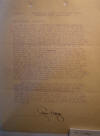
|
3.
October 8, 1927.
"Intelligence Report for the week ending October
8, 1927," Commanding Officer Glenn E. Hayes,
Ocotal, to Chief of the G.N.N., Managua, p. 3.
"[...] Subject:
Intelligence report for the week ending October
8, 1927, (continued). ¶ MISCELLANEOUS:
(continued) ¶ But two gangs of bandits are known
to be operating west of Santa Clara, that of
Anastacio Hernandez and the rather disorganized
group under Santos Lobo. The latter was reported
on October 2, 1927, to be in Santa Rosa and the
commanding officer of the troops in that area
was so advised. No reports have been received as
to the location or intentions of Hernandez. He
is a conservative and his method has usually
been to operate near the border with the
assistance of the conservative element on the
Honduras side. It is also reported that he has
received assistance from prominent conservatives
in this department and that at times they have
even directed his movements. He has been
described as “the private assassin of the
Pagaguas”. The latter are a family of
considerable means whose residence is in this
city. The only contact I have had with this
family has been to arrest one member thereof for
intoxication and to investigate the alleged
theft of a calf by one other member. This latter
case has not been decided and will probably
remain pending for a period of about one week.
The Pagaguas apparently have no social contact
with other people in the city and are generally
poorly thought of. Gustavo Pagagua was at one
time during the recent revolution Jefe Politico
of this Department and, from all reports, used
that office to further his own ends and nothing
else. These reports are from Conservatives and
Liberals alike. He is reported, in some
quarters, to be actively directing the movements
and depredations of Hernandez. ¶ Work has
progressed very satisfactorily on the
construction of a new runway at the aviation
field here. This work has been carried on by
laborers from this vicinity under the direct
supervision of Sergento Garcia of the Guardia.
This work will probably he completed during the
early part of the coming week. The runway now
used was constructed directly across the
prevailing wind with its consequential menace. I
believe that the new field constructed will
increase the factor of safety in taking-off by
at least fifty percent, and that safe landings
will be greatly facilitated thereby. ¶ Glenn E.
Hayes."
|
|
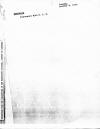
|
1.
October 8, 1927.
Conference with Henry L. Stimson, Gen. Emiliano
Chamorro, and others on the upcoming Nicaraguan
elections, p. 1.
"Tuesday, ¶ October 4, 1927. ¶ NICARAGUA ¶
Conference with H. L. S. [Henry L. Stimson]"
|
|
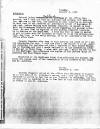
|
2.
October 8, 1927.
Conference with Henry L. Stimson, Gen. Emiliano
Chamorro, and others on the upcoming Nicaraguan
elections, p. 2.
"Tuesday, ¶ October 4, 1927. ¶ NICARAGUA ¶
Colonel Dufour telephoned Mr. Anderson
[“telephoned Mr. Anderson” is crossed out with
“called” handwritten above it] at the office
this morning, and I told him that Mr. Anderson
had already left Washington, was now in New
York, and expected to sail tomorrow at midnight.
He said that he had received Mr. Anderson’s
letter of September 30, and that, before talking
with General Chamorro, he wanted to talk with
the Nicaraguan Minister and others regarding the
general situation. He said that he expected to
see General Chamorro tomorrow. He is staying at
the Mayflower. I told him that in case he wanted
to get in touch with Mr. Anderson he could do so
at the Metropolitan Club, New York, in the early
morning, or at Mr. Anderson’s New York office
after that. ¶ General Chamorro also came in this
morning and asked me if I had the memorandum for
him. I told him that I had mailed it to Mr.
Anderson yesterday for revision and that I
expected it back either Wednesday or Thursday
and that I would deliver it to him immediately
after it was put in final form. I also told him
that I would deliver to him at the Mayflower
this afternoon the copies of the letters which
Mr. Anderson had Miss Thayer copy. ¶ Delivered
at the Mayflower Hotel this afternoon for
General Chamorro six copies each of the
translation of his letters to Dr. Cesar and Mr.
Anderson. ¶ Friday, ¶ November 4, 1927. ¶
General Chamorro called at the office this
afternoon to inquire as to the date of Mr.
Anderson’s return, and I told him that he was
expected to arrive in New York on the “Homeric”
on Wednesday, the 9th. He said that he expected
to be in New York at that time and would make an
effort to see Mr. Anderson. [...]"
|
|
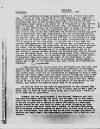
|
3.
October 8, 1927.
Conference with Henry L. Stimson, Gen. Emiliano
Chamorro, and others on the upcoming Nicaraguan
elections, p. 3.
"[...] Saturday, ¶ October 9, 1927. ¶ NICARAGUA
¶ I saw Secretary Kellogg by appointment at 9
o’clock this morning. He told me that the
position of the Department in regard to General
Chamorro’s candidacy in the coming Presidential
election in Nicaragua was that he was
disqualified under Article 104 of the Nicaraguan
Constitution, and would not be recognized by
this Government if elected. We discussed Article
104, the Spanish text of which he had before
him, and he admitted that it might be
interpreted differently, but that the Department
was interpreting it to mean that a citizen who
had exercised the Presidency during any part of
a presidential term was disqualified for the
succeeding period, and he said that the experts
in the Department had advised him that the
Spanish could be so interpreted and that he had
obtained a legal opinion to the effect that this
was a proper interpretation in view of the
purpose of the provision. I pointed out to him
that the literal interpretation was that “the
citizen who is exercising (or who may be
exercising) the Presidency is not eligible for a
succeeding term”, but he rejected this
rendering, and said that it would make the
provision meaningless if it permitted anyone who
is in the office to resign shortly before the
election and then be elected for the following
term. He is quite wrong about this, because the
purpose of the provision is to prevent the
individual in the office of President from
exercising the power of the Presidency to have
himself elected [“or nominated” handwritten
here] for another term, and it certainly cannot
apply to anyone who is not in the office at any
time during the Presidential campaign. ¶ I also
pointed out to him that this Government had
declared that General Chamorro was not the
Constitutional President of Nicaragua while he
was exercising the presidential power, and that,
of course, the Constitution could not be
interpreted as applying to such a case, because
that would imply that the Constitution
recognized that a man who was not President
constitutionally could exercise the presidential
power. He said that he did not think my point
was well taken, but as he had no time to give to
a discussion of the matter at the moment, any
further discussion would have to be postponed. ¶
He told me that he had made an appointment to
see General Chamorro and the Nicaraguan Minister
at 10 o’clock, and he said that he would like to
have me come in with them, and I told him I
would do so if they had no objection. ¶ Between
the two appointments I saw General Chamorro and
told him what Secretary Kellogg had said, and
advised him in his interview with the Secretary
not to raise the question of his candidacy, so
as not to give him a chance to state officially
to them what he had stated to me, and that in
order to avoid bringing up this point he should
say that there was a number of matters
concerning the Nicaraguan situation which he
would like to talk over with him at his
convenience, and that he was to be here through
the month of October and would await the
Secretary’s pleasure for a further conference.
[...]"
|
|
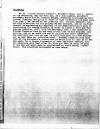
|
4.
October 8, 1927.
Conference with Henry L. Stimson, Gen. Emiliano
Chamorro, and others on the upcoming Nicaraguan
elections, p. 4.
"[...] NICARAGUA ¶ At 10 o’clock General
Chamorro, Minister Cesar, and I, called on the
Secretary, who had with him, as I anticipated,
Assistant Secretary White and Mr. Stokley
Morgan, evidently anticipating that General
Chamorro was going to raise at this conference
the same question that I had raised at the
previous one. General Chamorro very skillfully
carried out the program we had arranged, and he
confined himself to expressing his approval of
the Administration’s plan of supervising the
coming election in order to insure a free and
fair popular decision, and I told the Secretary
that I had explained to General Chamorro that he
had very little time at his disposal this
morning, and so we would not ask to go into any
other questions. The Secretary had told me that
he could only give us a few minutes and we must
make our interview short. General Chamorro then
said that at the Secretary’s convenience he
would like to come in to see him again for a
longer discussion of some important matters, and
the Secretary said that after Mr. Olds got back
he would be glad to see him and would make an
appointment at their mutual convenience. The
interview terminated on that basis."
|
|
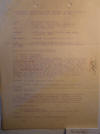
|
1.
October 15, 1927.
"Intelligence Report for the week ending October
15, 1927," Commanding Officer Glenn E. Hayes,
Ocotal, to the Chief of the G.N.N., Managua, p.
1.
"Headquarters, Division of Nueva Segovia,
Guardia Nacional de Nicaragua, Ocotal,
Nicaragua, October 15, 1927. ¶ From: The
Commanding Officer. ¶ To: The Chief of the
Guardia Nacional de Nicaragua, Managua[,]
Nicaragua. ¶ Via: Official Channels. ¶ Subject:
Intelligence report for the week ending October
15, 1927. ¶ Reference: Paragraph 15, Special
Order # 60. ¶ 1. In accordance with the
provisions of the reference, I report as follows
for the week ending October 15, 1927: ¶ GENERAL
STATE OF TERRITORY OCCUPIED: ¶ Ocotal –
peaceful. ¶ Jicaro – peaceful. ¶ Intervening and
adjacent terrritory [territory] – disturbed.
Bandits under Carmen Torrez with a strength of
about 150 men are reliably reported to be
operating in Jalapa – Muyuca – Arinal – La
Puerta area. Residents of San Fernando and Santa
Clara are still living at Aryan in fear of
depredations by this band. Anastacio Hernandez
with a band whose strength is not known but is
not believed to be in excess of fifty men, is
reported to be operating in the El Potrero – San
Fabian – Dipilto area and but few houses in the
area are occupied by their owners or regular
tenants. ¶ Attitude of Civil Population Toward
Forces: ¶ No change noted in area occupied or in
adjacent territory. ¶ ECONOMIC CONDITIONS: ¶ No
change in conditions noted in my reports of
October 1 and 8, 1927, except that increasingly
inclement weather is hampering travel on the
roads to an even greater degree. Some merchants
are now handling their own pack trains due to
their inability to secure muleros and packers to
do so. ¶ ATTITUDE OF PRESS: ¶ No press in
Division. ¶ No information received as to
attitude of foreign press. ¶ FRICTION BETWEEN
TROOPS AND CIVIL POPULATION: ¶ None. [...]"
|
|
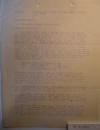
|
2.
October 15, 1927.
"Intelligence Report for the week ending October
15, 1927," Commanding Officer Glenn E. Hayes,
Ocotal, to the Chief of the G.N.N., Managua, p.
2.
"[...] Subject: Intelligence report for week
ending October 15, 1927. ¶ POLICE OPERATIONS: ¶
See police report of even date. ¶ MILITARY
OPERATIONS: ¶ On October 9th, 1927, a patrol
under the command of 1st Lieutenant George
O’Shea, consisting of ten marines and ten
Guardia, together with Captain John B. O’Neill,
Guardia Nacional, was proceeding to the scene of
the crash of the plane piloted by Lieutenant
Thomas near Quilali. They were attacked by a
force of about 200 bandits near the scene of the
crash which force was later augmented by about
175 more bandits. They fought their way through
one of the smaller forces and made their way
down stream beds to Jicarito, continuing their
journey to Jicaro by road. During the engagement
near the scene of the crashed plane four members
of the Guardia Nacional were killed. No other
casualties were suffered by the patrol in this
operation. The names of the men killed in action
are as follows: ¶ Sergento Porfirio Melendez,
#101, ¶ Raso Juan Benavides, #35, ¶ “ Luis
Bustos, #122, and ¶ “ Francisco Gutierrez, #6. ¶
Lieutenant O’Shea reports that all members of
the Guardia Nacional who were members of this
patrol conducted themselves with great coolness
under fire, and that their work generally was a
credit to our organization. Recommendation for
citation and decoration of these men has been
made the subject of separate communications. ¶
Captain Roger W. Peard, Marine Corps, arrived at
Ocotal with a patrol of seven men arrived from
Pueblo Nuevo at 7:30 PM, August 9, 1927. He
reported the area covered clear. ¶ A patrol
consisting of thirty marines under the command
of Gunnery Sergeant Gordon, left Ocotal for
Jicaro with a ration train at 0800 October 12,
1927, arriving at the latter place in the early
evening October 13, 1927. They reported the road
clear. ¶ A patrol under my personal command left
Ocotal at 0400 this date for Mosonte. This
patrol consisted of thirteen mounted marines,
three Guardia, and Lieutenant Chappell of the
Marine Corps. The mission of this patrol was to
capture certain alleged murderers known to
reside in that city and to search the town for
arms which were believe [believed] to be there.
[...]"
|
|
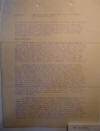
|
3.
October 15, 1927.
"Intelligence Report for the week ending October
15, 1927," Commanding Officer Glenn E. Hayes,
Ocotal, to the Chief of the G.N.N., Managua, p.
3.
"[...] Subject: Intelligence report for the week
ending October 15, 1927 ¶ The patrol
accomplished its mission, capturing four persons
alleged to have participated in the murder of
Geroncio Florian on September 29, 1927, at Los
Arados, and confiscating one rifle found in a
house occupied by women. The patrol returned to
Ocotal at 0830 the same date without further
incident. (See police report of even date for
information in greater detail) ¶ MISCELLANEOUS:
¶ Difficulty has again been experienced this
week in maintaining telegraphic communication
with Jicaro. This has been due to enemy
sympathizers cutting the line near Sabana Grande
on October 11th, and to the heavy rains which
have caused short circuits. The operators
experience particular difficulty in the early
morning, but as the lines become dried out the
work becomes easier. The lines at best are
poorly insulated being strung usually between
trees. All patrols, however, carry a machete and
are instructed to cut branches back from the
line whereever [wherever] observed near it. ¶
Santos Lobo, a bandit leader in the Pueblo Nuevo
area was killed on the night of October 11th, at
a house about six miles north west of that city.
It is reported that he attempted to rape the
wife of the owner of this house, one Oresco, and
that the latter killed him with a knife, another
person hitting him at the same time with a
machete. Lobo’s men attempted to capture Oresco
but he escaped and made his way to Pueblo Nuevo,
reporting the facts to the commanding officer of
marines there. A patrol under the command of 1st
Lieutenant Merton A. Richal, Marine Corps,
proceded [proceeded] to the scene the next day
and exhumed the body, verifying the
identification. It is believed that his death
will disorganize his band which was composed,
principally, of Honduranian [Honduran] thugs and
murderers. Seven of the band were captured by
Lieutenant Richal’s patrol and one killed in
addition to Lobo. ¶ A frightfully brutal murder
occurred about 2000 yards east of this city
during the night of October 13 – 14. Four men
were attacked from behind with machetes and
literally hacked to pieces. These persons had
evidently been brought from some distance to the
scene of the crime and were apparently
defensless [defenseless] as two of the [them]
were tied together with rope. Their bodies were,
to all appearances, purposely left in the center
of the main road as a warning to the populace of
the town and to the military garrison. Two
bodies were identified as persons from the
vicinity of Telpaneca and it is believed that
they were brought as prisoners from that area.
(See police report of even date.) [...] "
|
|
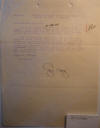
|
4.
October 15, 1927.
"Intelligence Report for the week ending October
15, 1927," Commanding Officer Glenn E. Hayes,
Ocotal, to the Chief of the G.N.N., Managua, p.
4.
"[...] Subject: Intelligence report for the week
ending October 15, 1927. (continued). ¶
Miscellaneous: (Continued) ¶ Sanchez was
reported [“on Oct 11th” handwritten here] to be
in the vicinity of El Sapote, a small village
between Ciudad Antigua and the OCOTAL – JICARO
road, with 150 men. This report was made by one
Julio Maridiaga, who is considered reliable. ¶
Work has been about completed on the new runway
for airplanes at the aviation field here. All
that is left to be done is to clear one corner
of cut brush, lop off a few trees, and
“fine-comb” the area for twigs and thorns. The
aviators have used this runway several times and
are very enthusiastic over it. The new field
with the old one affords them an opportunity to
land or take off in any one of six directions
desired[.] ¶ POLITICAL SITUATION: ¶ No changes.
¶ Glenn E. Hayes."
|
|
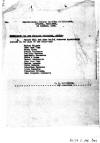
|
October 16, 1927. "Memorandum for
the Division Commander, Ocotal," S. M.
Harrington, By direction, Managua.
"HEADQUARTERS, GUARDIA NACIONAL DE NICARAGUA, ¶
MANAGUA, NICARAGUA. ¶ 16 October, 1927. ¶
MEMORANDUM FOR THE DIVISION COMMANDER, OCOTAL: ¶
1. Please fill out form [unreadable, possibly
“No. I-1”] whenever opportunity permits in the
case of the following: ¶ Carlos Salgado ¶ Jose
Leon Diaz ¶ Simon Jiron ¶ Tonbio Solorzano
[Toribio Solórzano] ¶ Porfirio Sanchez ¶
Anastacio Hernandez ¶ Pedro A Irias ¶ Manuel
Echeverria ¶ Jose Leon Diaz ¶ Carlos Quezado ¶
Pedro Navarro ¶ Sebastian Barahona ¶ Simon
Gonzalez ¶ Francisco Estrada. ¶ Juan Gregorio
Colindres ¶ S. M. HARRINGTON, ¶ By direction"
|
|
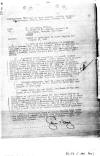
|
October 18, 1927. "Report of
conditions in Nueva Segovia for October 17,
1927," Commanding Officer Glenn E. Hayes,
Ocotal, to the Chief of the G.N.N., Managua.
"Headquarters, Division of Nueva Segovia,
Guardia Nacional de Nicaragua, Ocotal,
Nicaragua, October 18, 1927: ¶ From: The
Commanding Officer. ¶ To: The Chief of the
Guardia Nacional de Nicaragua, Managua,
Nicaragua. ¶ DIRECT ¶ Subject: Report of
conditions in Nueva Segovia for October 17,
1927. ¶ 1. In view of the interruption of
telegraph service between this city and Managua,
which is believed to have been caused by the
heavy recent storms, it was impossible to report
the conditions in this division by that means. A
written report for that date is, therefore,
submitted: ¶ (a) A mounted patrol consisting of
myself, Second Lieutenant Clarence J. Chappell,
Marine Corps, three enlisted men of the Guardia
Nacional, and accompanied by the Criminal Judge
of thedistrict [the district] and the Director
of Sanidad, cleared Ocotal at 1430 on October
17, 1927, to investigate the reported murder of
two men at San Fabian. The latter place is
located about two leagues north of this city on
the OCOTAL-DIPILTO road. Upon arriving thereat
search disclosed the bodies of two men in one of
the houses. These men were apparently brutally
murdered with machetes, being cut about the head
and body. They were identified as: ¶ Valentin
Rodriguez, aged 21 years, a resident of Ocotal,
and a servant in the employ of Señor Don Jose
Peralta of the city. ¶ Pedro Gomez, age not
known, residence at his own ranch in the Dipilto
Mountains. ¶ No reasons or motives are known for
this crime, but it is believed that it was
committed by members of a band of thugs under
Anastacio Hernandez, who has been reported in
that locality. Rodriguez was a Conservative and
Gomez a Liberal. The bodies, which had
apparently been in the position in which found
for three or four days, were buried on the spot,
and the patrol returned to Ocotal without
further incident[.] ¶ (b) Lieutenant Bruce at
Jicaro reports that there are persistent rumors
in that city that Lieutenant Thomas and Sergeant
Dowdell worked their way across country and
arrived at Telpaneca. ¶ Glenn E. Hayes."
|
|
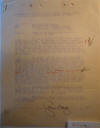
|
October 19, 1927. "Report of
conditions Nueva Segovia for October 18, 1927,"
Commanding Officer Glen E. Hayes, Ocotal, to the
Chief of the G.N.N., Managua.
"Headquarters, Division of Nueva Segovia,
Guardia Nacional de Nicaragua, Ocotal,
Nicaragua, October 19, 1927. ¶ From: The
Commanding Officer. ¶ To: The Chief of the
Guardia Nacional de Nicaragua, Managua,
Nicaragua. ¶ Subject: Report of conditions Nueva
Segovia for October 18, 1927. ¶ 1. At 4:00 pm
October 17, 1927, while I was on patrol to San
Fabian, an inhabitant of Mosonte reported firing
near that city. Captain Roger W. Peard, Marine
Corps, who was in the city of Ocotal at that
time, dispatched a marine patrol to Mosonte to
investigate the occurrence. That patrol left at
6:45 pm the 17th and returned at 3:00 AM the
18th. This patrol reported no enemy activity at
Mosonte but stated that the inhabitants were
very frightened and were in the brush. ¶ 2. Juan
Amaya, aged 62 years, and Jose Angel Amaya, aged
17 years, appeared at these headquarters for
medical treatment, the former suffering from a
gunshot wound in the left bicep and the latter
from a serious machete cut on the right side of
the head. These men reside at El Rodeo on the
Quisuli River about two miles north of the
Ocotal-Jicaro road. They reported that a group
of men came to El Rodeo at about 4:00 PM on
October 17, 1927, tied up the women and made the
statement that they would take them before “the
General” that evening. The men residing there
fled but in their flight were attacked by
members of this band receiving the wounds
reported. In addition Jose Expectacion Amaya was
killed. The women escaped and their captors left
the town in a northerly direction. ¶ 3. No
reports have been received as to general enemy
activity in the vicinity of Jicaro. Lieutenant
Bruce states that there [are] no rumors in that
city as to any changes in the enemy’s
dispositions to the eastward. ¶ 4. This report
is transmitted by letter in view of the poor
reported communication by telegraph between this
city and Managua. ¶ Glenn E. Hayes."
|
|
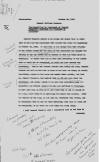
|
1.
October 22, 1927.
"Conversation. General Emiliano Chamorro.
Non-recognition by Department of General
Chamorro's candidacy for President of
Nicaragua," Francis W. White, Washington, p. 1.
"Conversation. ¶
October 22, 1927. ¶ General Emiliano Chamorro ¶
Non-recognition by Department of General
Chamorro’s candidacy for President of Nicaragua.
¶ General Chamorro called on me to-day and
stated that he would like to know how the
Department felt towards him since the happenings
of October 25, 1925. He said that he had always
been very friendly to the United States and was
sorry if the Department had changed its feeling
in any way toward him on account of what had
taken place in Nicaragua. He stated that had he
been told definitely at the outset that he would
not be recognized, he would not have assumed the
presidency. When he and General Estrada were
taking the Loma, General Estrada had said to him
that as soon as the Loma was taken, he should
immediately return to his house and remain there
quietly, but that he, General Chamorro, had
replied that he did not care about the
presidency, but merely wanted to be sure that
everything went off peacefully and without
causing trouble and uprisings in Nicaragua. He
felt sure that as soon as it was known that he
was in charge of the Loma, there would be no
uprisings throughout the country. After the
seizure of the Loma, he had seen Mr. Eberhardt
very little, and he complained that he had not
been definitely told that he would not be
recognized, or he would not have taken the final
steps. ¶ I told General Chamorro that I
understood that he had been so ¶ informed, […] "
|
|
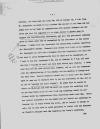
|
2.
October 22, 1927.
"Conversation. General Emiliano Chamorro.
Non-recognition by Department of General
Chamorro's candidacy for President of
Nicaragua," Francis W. White, Washington, p. 2.
"[…] informed, and
then read him cable No. 150 of October 25, 3
P.M. from Mr. Eberhardt, in which he had
reported the seizure of the Loma and had added
that he had been in communication with General
Chamorro and advised him that the Legation had
no other course to pursue than to support the
Constitutional Government, and that any
government assuming power by force would not be
recognized by the Government of the United
States. I added that the Department had
immediately replied, approving Mr. Eberhardt’s
action. Chamorro also stated that later on in
December Mr. Eberhardt had read him a telegram
from the Department, but this did not seem to
state categorically that he would not be
recognized, so I read to him the Department’s
No. 114 of December 9, 7 P.M. and told him that
I thought it could not have been stated more
clearly. I added that this was all past history
now, however, and we were now concerned with the
rehabilitation of the country and the mending of
damage that had been done. General Chamorro
stated that he would like the Department in some
way to indicate that it was not unfriendly to
him, and as he put it “restore his civil
rights”. He added that he wanted to return to
Nicaragua and that he would not launch his
candidacy when he got down there as he did not
think any candidacy should be proclaimed until
the Conservative Party Convention meets next
May. There are several candidates for the
nomination and should any candidacy be launched
now it would divide the party, and he thought it
better to wait, but he said that he would
guarantee to confer with our Minister or Chargé
in Managua next May regarding the Party’s
candidate, ¶ and […]"
|
|
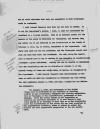
|
3.
October 22, 1927.
"Conversation. General Emiliano Chamorro.
Non-recognition by Department of General
Chamorro's candidacy for President of
Nicaragua," Francis W. White, Washington, p. 3.
"[…] and he would
undertake that only one acceptable to this
Government would be nominated. ¶ I told General
Chamorro that this was not what we wanted. It is
not the Department’s policy, I said, to pick out
candidates for President in a foreign country.
That is an internal matter for the members of
the party to determine for themselves, and
whoever they may select who is not debarred by
the Constitution or the Treaty of February 7,
1923, is, of course, acceptable to the
Department. Each party must pick out its own
candidate, and the Nicaraguan people must pick
out from them their own President. The only
thing the Department is called upon to say is
whether it can recognize as Constitutional
President a given individual. Anybody who can be
elected in accordance with the Constitution and
not in violation of Article II of the General
Treaty of Peace and Amity would, of course, be
recognized by the Department. I told General
Chamorro that unfortunately in his case we could
not give him recognition as President any time
during the term beginning January 1, 1929, and
then I handed him the following statement:- ¶
“On January 1, 1929, the Government of the
United States will be confronted by the
necessity of deciding whether it can
consistently recognize the incoming
administration in Nicaragua as the
constitutional government of that country. While
the United States is not supporting or opposing
any political candidate it is most desirous that
there should be no question at that time as to
the eligibility under the constitution of the
person who may have prevailed at the
presidential elections, since it wishes to
extend the fullest and most sympathetic
cooperation to the new government. ¶ “In […]"
|
|
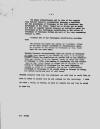
|
4.
October 22, 1927.
"Conversation. General Emiliano Chamorro.
Non-recognition by Department of General
Chamorro's candidacy for President of
Nicaragua," Francis W. White, Washington, p. 4.
"[...] In these
circumstances and in view of the reports that
General Chamorro contemplates becoming a
candidate for the presidency of Nicaragua in the
1928 elections, the Government of the United
States has no choice but to point out that it
regards General Chamorro as ineligible under the
provisions of the Nicaraguan constitution to the
office of President of Nicaragua during any part
of the term commencing January 1, 1929. ¶
“Article 104 of the Nicaraguan constitution
provides that ¶ ‘No citizen who holds the office
of President, either as the duly elected
incumbent or accidentally, shall be eligible to
the office of President or Vice President for
the next term.’ ¶ General Chamorro
unquestionably held the office of President de
facto from January 17 to October 20, 1926, thus
bringing himself within the prohibition of
Article 104 of the Constitution and Article II
of the General Treaty of Peace and Amity of
February 7, 1923, thus making it impossible for
the Government of the United States to regard
him as eligible to the office of President of
Nicaragua for the term beginning January 1,
1929, or to recognize him as the Constitutional
President of Nicaragua if he should claim or
attempt to occupy the office during any part of
said term.” ¶ General Chamorro read over the
statement and said that he would like to come in
later to confer with me and perhaps see the
Secretary. I told him that I would, of course,
be glad to receive him any time he cared to come
in. ¶ A-L FW:MM"
|
|
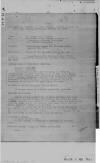
|
October 22, 1927. "Intelligence
report for the week ending October 22, 1927,"
Commanding Officer Glenn E. Hayes, Ocotal, to
Chief of the G.N.N., Managua, p. 1 only.
"Headquarters,
Division of Nueva Segovia, Guardia Nacional de
Nicaragua, Ocotal, Nicaragua, October 22, 1927.
¶ From: The Commanding Officer. ¶ To: The Chief
of the Guardia Nacional de Nicaragua, Managua,
Nicaragua. ¶ Via: Official Channels. ¶ Subject:
Intelligence report for the week ending October
22, 1927. ¶ Reference: Paragraph 15, Special
Order # 60, G.N. ¶ 1. In accordance with the
provisions of the reference, I report as follows
for the week ending October 22, 1927: ¶ GENERAL
STATE OF TERRITORY OCCUPIED: ¶ Ocotal –
peaceful. ¶ Jicaro – peaceful. ¶ Intervening and
adjacent territory – disturbed. Carmen Torrez is
still reported to be in the Santa
Clara-Jalapa-Jicaro triangle with strength in
excess of one hundred. Anastacio Hernandez with
his gang of thieves and murderers is still at
large and has committed crimes in territory to
the north and east during the week. ¶ ATTITUDE
OF CIVIL POPULATION TOWARD FORCES: ¶ No change
noted in attitude previously reported. ¶
ECONOMIC CONDITIONS: ¶ Prices of food-stuffs and
of other articles that must be packed or carted
in from the interior are still up. Some cargoes,
however, have arrived this week. There has been
little rain this week and it is believed that
pack trains will be moving regularly within a
short time. ¶ Labor is plentiful but there is
but little employment for the men within the
city, and they are hesitant to leave it. A
considerable number, however, have been employed
at the aviation field in the clearing of a new
runway. ¶ ATTITUDE OF PRESS: ¶ No press in
Division. ¶ No information received as to
attitude of foreign press. ¶ FRICTION BETWEEN
TROOPS AND CIVIL POPULATION: ¶ None."
|
|
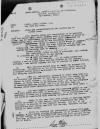
|
October 23, 1927. "Study and
recommendations for patrolling of Coffee Zone,"
Lieut. Lewis Miller, Managua, to Jefe Director,
G.N.N., Managua.
"HEADQUARTERS, GUARDIA NACIONAL DE NICARAGUA, ¶
MANAGUA, NICARAGUA. ¶ 23 October, 1927. ¶ From:
Lieut. Lewis Miller, G.N. ¶ To: The Jefe
Director. ¶ Subject: Study and recommendations
for patrolling of Coffee Zone. ¶ 1. From careful
study and observation it is believed that the
entire zone, which extends over a distance of
about 30 miles, can be effectively patrolled and
order maintained by establishing small out-posts
at the following places:- ¶ [the word
“Englaterra” is typed here, but crossed out,
with what appears to be “Cañon” handwritten next
to it], which is about 8 miles south of Managua,
¶ El Crucero, where the road branches off in
three directions, one leading to Managua, one to
Diriamba and San Marcos and doubling back to
Managua, ¶ Buenos Aires, ¶ San Francisco, which
is also a crossroad, one leading to Diriamba and
the other to San Marcos, ¶ at or near Diriamba
and one ¶ at or near San Marcos. All of these
places are between 8 and 10 miles apart and are
located on the Managua – Diriamba – San Marcos
highway and can be reached by motor vehicle. ¶
2. Each out-post should have at least two
animals for patrolling. In addition to the above
out-posts there should be a mounted roving
patrol maintained for the purpose of visiting
all outlying plantations. ¶ 3. From all
information gathered it would seem that all the
disorder and murders in that region during the
season can be traced to three things: - (1) Sale
of illicit liquor, known as Cueusa, of which
there is an enormous flow, (2) to the presence
of numerous gambling places, and (3) to the fact
that all workmen carry their machettes
[machetes] with them during the week ends. ¶ 4.
The undersigned noticed that numerous people on
the road were armed with what is known as a
“Cutacha,” which is not an implement of work but
a fighting weapon. It is recommended that the
above be considered when drawing up orders for
the patrol. ¶ 5. Owing to the fact that very
little of anything except coffee is raised in
that region, small detachments may find it
difficult to subsist on the standard ration. Not
all of the plantations have living quarters for
the men, therefor tentage should be taken along.
¶ 6. Whiel [While] at Diriamba the undersigned
learned that Cato Sanchez, a well known Liberal
freebooter, is at present somewhere in that
region. He is credited with numerous hold ups
and cattle stealing. Although not a fugitive
from justice he keeps himself out of sight. ¶
LEWIS MILLER"
|
|
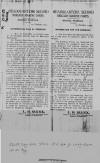
|
October 25, 1927. "Information for
the Command," Bilingual public flier signed by
Col. L. H. Gulick, U.S.M.C.
"HEADQUARTERS SECOND BRIGADE MARINE
CORPS, ¶ MANAGUA, NICARAGUA. ¶ 25 Octubre 1927.
¶ INFORMACION PARA EL COMANDO ¶ 1.—El 6
de noviembre en muchos lugares de Nicaragua
tendrán lugar las Elecciones Municipales. ¶ Las
Fuerzas Americanas están interesadas en que
estas Elecciones sean conducidas observando la
Ley y sin desórdenes. La presencia de Marinos en
las numerosas Mesas Electorales obedece a
propósitos de observación, y para recoger datos
acerca de las causas de desórdenes, los cuales
datos conforme se obtengan serán usados para la
supervisión de las Elecciones Presidenciales, en
noviembre de 1928. ¶ 2.—Hágase saber a todos los
interesados que nuestras fuerzas estarán
presentes en las Mesas Electorales el 6 de
noviembre de este año solamente con propósitos
de observación y todos los participantes tomarán
precauciones para que la presencia de los
Marinos en estas Elecciones no dé lugar a ningún
partido para criticar su conducta en lo
referente a neutralidad. ¶ 3.—Los Jefes de
Patrullas rendirán un informe detallado de sus
observaciones, y se referirán en sus informes a
la causa o causas que puedan originar desórdenes
en las Mesas Electorales, teniendo mucho cuidado
de señalar si es el Partido Liberal o el
Conservador el responsable por los desórdenes. ¶
4.—Los intérpretes que acompañen a los Marinos
serán requeridos para prestar juramento en el
sentido de que ellos no favorecerán por ningún
acto o interpretación, ninguno de los dos
partidos en las próximas Elecciones. Los
intérpretes que acompañen a los Marinos el 6 de
noviembre de este año serán seleccionados la
mitad de tendencias conservadoras y la mitad de
tendencias liberales. ¶ L. H. GULICK, ¶ Colonel,
U. S. Marine Corps, Commanding Second Brigade,
U. S. Marine Corps. ¶ HEADQUARTERS
SECOND BRIGADE MARINE CORPS, ¶ MANAGUA,
NICARAGUA. ¶ 25 October, 1927. ¶ INFORMATION FOR
THE COMMAND ¶ 1.—On November 6th
Municipal Elections are to take place in
numerous places of Nicaragua. ¶ The American
Forces are interested that these elections be
conducted with the law being observed and
without disorder. The presence of Marines at the
numerous polling places are for the purpose of
observation and the gathering of data as to
causes of disorder, such data as is accumulated
to be used in the supervision of the
Presidential Elections in November, 1928. ¶
2.—Let it be known to all concerned that our
forces are only present at the polling places on
November 6th of this year for the purpose of
observation and all concerned will take every
precaution that the presence of Marines at these
elections will, in no way, cause either party to
criticize their conduct as to neutrality. ¶
3.—The leaders of patrols will render detailed
reports of their observations and will bring out
in their reports the cause or causes that may be
responsible for disorders at the polls, being
careful to point out whether the Liberal or
Conservative Party is responsible for the
disorder. ¶ 4.—Interpreters accompanying Marines
will be required to take an oath that they will
not, by any act or interpretation, favor either
party in the coming elections. Interpreters
accompanying Marines on November 6th of this
year will be selected, half having Conservative
tendencies and half having Liberal tendencies. ¶
L. H. GULICK, ¶ Colonel, U. S. Marine Corps,
Commanding Second Brigade, U. S. Marine Corps."
|
|
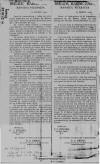
|
October 25, 1927. Bilingual public
letter of instructions to all interpreters
employed by the Marine Corps for duty during the
Election Period November 6, 1927, by order of
Second Brigade Commander Lieutenant-Colonel B.
S. Berry, U.S.M.C.
"..."
|
|
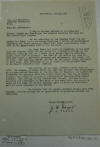
|
October 26, 1927. Letter from J.
A. Fagot, Bluefields, to U.S. Consul A. J.
McConnico, Bluefields.
"Bluefields, Oct. 26, 1927 ¶ Hon. A.J.
McConnico, ¶ American Consulate, ¶ City. ¶ Dear
Mr. McConnico:- ¶ I beg to enclose letters of
L.S. Mena and Messrs. Zepada and Guandique, the
lawyers handling the case for The Albert Fagot
Company. ¶ As the secretary of the Supreme Court
did not answer Mr. Mena, he is enclosing
Guandique’s letter of notification regarding the
court decision, dated July 14th; accordingly,
that must be the approximate date of the
decision. ¶ Mr. Mena bases his claim of
injustice on the fact that the Supreme Court did
not allow his brother’s protest on the records,
claiming that he (Mena) being Albert Fagot’s
attorney, should have done so himself. The fact
of the matter is, that Mr. Mena was first, a
political prisoner and afterwards, was chased
out of town. The opposing lawyer, as well as the
Court, being cognizant of this fact, took
advantage of it to throw out the protest made by
Dr. Mena’s brother in his absence. ¶ The history
of the case, however, dates back to 1920. Mr.
Ibarra, in whose favor the case was decided, was
Commandante at a place called Waspook, on the
Rio Coco or Segovia. He signed two contracts for
mahogany with The Albert Fagot Co. One, to be
worked himself, the other to consist of
purchases of mahogany from Indian cutters. The
cutting by the Indians was illegal, but due to
his position and influence, he was able to get
away with. His claim is based on the logs cut by
the Indians, part of which he delivered, part of
which remained in the creeks. ¶ We believe that
Mr. Mena’s protest should have been allowed,
thereby giving him an opportunity to properly
protect our interests. ¶ Respectfully yours, ¶
J. A. Fagot."
|
|
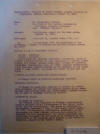
|
1.
October 29, 1927.
"Intelligence report for the week ending October
29,1927," Commanding Officer Glenn E. Hayes,
Ocotal, to the Chief of the G.N.N., Managua, p.
1.
"Headquarters, Division of Nueva Segovia,
Guardia Nacional de Nicaragua, Ocotal,
Nicaragua, October 29, 1927. ¶ From: The
Commanding Officer. ¶ To: The Chief of the
Guardia Nacional de Nicaragua, Managua,
Nicaragua. ¶ Via: Official Channels. ¶ Subject:
Intelligence report for the week ending October
29, 1927. ¶ Reference: Paragraph 15, Special
Order # 60, G.N. ¶ 1. In accordance with the
provisions of the reference, I report as follows
for the week ending October 29, 1927: ¶ GENERAL
STATE OF TERRITORY OCCUPIED: ¶ Ocotal –
peaceful. ¶ Jicaro – peaceful. ¶ Intervening and
adjacent territory – disturbed. Bands of bandits
reported during the week operating in Dipilto,
Sabana Grande, and Ciudad Antigua areas under
command of Anastacio Hernandez, Encarnacion
Lopez and Simon Gonzalez respectively. Bands
were also reported active in the vicinity of San
Lucas, which is near Somoto, and along the
border to the west and north. ¶ ATTITUDE OF
CIVIL POPULATION TOWARD FORCES: ¶ No change
noted in attitude previously reported. ¶
ECONOMIC CONDITIONS: ¶ No change in conditions
reported on October 22, expect that continued
dry weather has allowed traffic on the roads to
move with greater ease and, consequently,
produce is coming to town in steadily increasing
amounts. ¶ ATTITUDE OF PRESS: ¶ No press in
Division. ¶ The Revista Ariel continues to
display a particularly hostile attitude to the
intervention of the United States in the affairs
of Nicaragua. This paper is published at
Tegucigalpa, Honduras. A copy of that paper,
dated October 15, 1927, and containing
particularly subversive Sandino propaganda and
other violent anti-American comments, is
enclosed for your information. This paper
apparently has absolutely no regard for the
truth as is evidenced by its publication of the
palpably false account of the action at
Telpaneca, signed by the bandit Sandino. [...]"
|
|
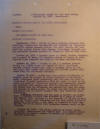
|
2.
October 29, 1927.
"Intelligence report for the week ending October
29,1927," Commanding Officer Glenn E. Hayes,
Ocotal, to the Chief of the G.N.N., Managua, p.
2.
"[...] Subject: Intelligence report for the
week ending October 29, 1927, (continued). ¶
FRICTION BETWEEN TROOPS AND CIVIL POPULATION: ¶
None. ¶ POLICE OPERATIONS: ¶ See police report
of even date. ¶ MILITARY OPERATIONS: ¶ October
23, 1927 – Patrol of seven marines returned from
escorting Lieutenants Trojakowski and Townsend
to Lieutenant Chappell’s column enroute Jicaro.
The four guardia who were with that patrol
joined that column. Lieutenant Chappell and his
augmented command arrived at Jicaro at 1755 on
that date. ¶ October 24, 1927 – Captain Roger W.
Peard, Guardia Nacional, and a patrol of seven
(7) marines arrived at Ocotal at 1400. Captain
Peard reported for duty at Division
Headquarters. ¶ October 25, 1927 – Patrols of
six (6) marines cleared Ocotal for Pueblo Nuevo
and Somoto at 0800. Lieutenant Chapell
[Chappell?] cleared Jicaro for scene of crashed
plane in Quilali area with twenty five marines
and fifteen guardia plus Cadet Neel and
Lieutenant Townsend. ¶ October 27, 1927 – Planes
were very active in vicinity of crashed plane in
efforts to effect junction of the column under
Lieutenant Gould proceeding from the east and
that of Lieutenant Chappell proceeding from the
west. An area to the north and south of
Lieutenant Chappell was thoroughly bombed and
straffed [strafed] with machine gun fire as
Chappell reported to the planes that the
situation was serious and that the enemy was
located in those areas. The enemy was well
hidden in the underbrush but the pilots believe
that they inflicted heavy casualties. ¶
Anastacio Hernandez and his gang of bandits and
criminals is reported to have been attacked by a
group of about two hundred (200) Liberals in the
vicinity of Dipilto on this date and to have
been dispersed and his band either killed or
captured. Jose Torrez, a sub jefe, is reported
to have been killed, but it is stated that
Hernandez escaped early in the fighting[.] ¶
October 28, 1927 – One plane, piloted by Marine
Gunner Wodarczyk, reconnoitered the Dipilto area
and reported several burned and burning houses.
He bombed and straffed [strafed] areas that he
suspected. [...]"
|
|
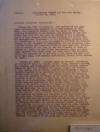
|
3.
October 29, 1927.
"Intelligence report for the week ending October
29,1927," Commanding Officer Glenn E. Hayes,
Ocotal, to the Chief of the G.N.N., Managua, p.
3.
"[...] Subject: Intelligence report for the
week ending October 29, 1927. ¶ MILITARY
OPERATIONS (continued): ¶ October 28, 1927
(continued): Two members of the gang inder
[under?] Hernandez were captured by me this
morning in this city. They confirmed reports
that the gang, of which they admitted themselves
to be members, was attacked on the preceding
day. They did not know the number of the
attacking force as they escaped early in the
fighting but stated that the strength was
“bastante”. It is, therefore, believed that the
dispersion of this gang was complete and that
its reorganization in any strength is
improbable. The men captured, i.e., Augustin
Flores and Francisco Martinez have both been
identified as members of the gang of men who
attacked El Rodeo on October 17, 1927, and who
killed Expectacion Amaya and seriously wounded
Jose Angel Amaya and Juan Amaya. The
identification was complete as it was made by
the women who were tied up by this gang. (See
special confidential report dated October 19,
1927). ¶ October 29, 1927- A patrol under my
command, consisting of Lieutenant David K.
Claude, Marine Corps, fourteen marines, two
Guardia, one interpreter, and two native guides,
cleared Ocotal at 0030 for Coyolito and Sabana
Grande. The mission of this patrol was to
attack, capture and disperse a gang of bandits
reported to be operating under the command of
Encarnacion Lopez in that area. The patrol
arrived at Totogalpa at 0230 and searched the
house of one Electerio Lopez who was reported to
be a member of that gang. He was not found in
his house or in the adjoining fields which were
searched. The patrol proceded [proceeded]
eastward at 0300 toward Sabana Grande. The point
of the patrol searched the house of Encarnacion
Lopez enroute at 0400 capturing that person and
one Trancito Lopez who was with him. The latter
had a rifle and threatened to shoot members of
the searching party but was forcibly disarmed.
Teodoro Lopez, another reported bandit chief,
was also captured but broke and ran while being
transferred to the main road. Thompson
sub-machine gun and rifle fire was directed upon
him but he made good his escape due to the
darkness. It is not known whether or not he was
wounded, but it is believed probable. The patrol
proceded [proceeded] toward Coyolito at 0430
arriving in the vicinity of that place at 0515.
Upon approaching the main house of the group,
the patrol was challenged and fired upon which
fire was returned. Several men were seen to flee
this house and fire was directed upon them, but
they presented but dim and fleeting targets in
the half-light of dawn. The house was then
rushed and Miguel Perez was captured. The houses
of the group were then searched but no […]"
|
|
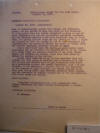
|
4.
October 29, 1927.
"Intelligence report for the week ending October
29,1927," Commanding Officer Glenn E. Hayes,
Ocotal, to the Chief of the G.N.N., Managua, p.
4.
"[...] Subject: Intelligence report for the
week ending October 29, 1927. ¶ MILITARY
OPERATIONS: (continued) ¶ October 29, 1927,
(continued): ¶ […] arms or incriminating papers
were found. Hot tortillas, queso, and hot coffee
in cups was found in the kitchens. It is
apparent that the patrol surprised a group of
men at their breakfast and had not exigencies
prevented maintaining the schedule planned would
have surprised them in their beds. The patrol
cleared Coyolito for Ocotal at 0610. A plane was
sighted at 0940 and panels KX and NZ were
displayed and acknowledged. The patrol continued
its march to Ocotal without further incident,
arriving thereat at 1030. ¶ Papers were found
upon the person of Encarnacion Lopez addressing
him as “capitan” and clearly [unreadable
handwritten word here] him to be the leader of a
group under the general guidance of one Jose
Julian Lopez, now residing in Somoto. Steps have
been taken to secure the capture of the latter.
¶ Miguel Perez admitted to me to have provided
food and shelter for this group of bandits over
a considerable period of time but claimed that
he had maintained them there as a protection
against the bandit Hernandez. This I do not
believe. On the contrary, I believe that he was
cognizant of the program of rape, pillage, and
murder engaged in by this gang and in other ways
actively assisted them. Witnesses are available
to testify against all of the men captured, when
their cases are called. ¶ MISCELLANEOUS: ¶
Telegraph communication has been maintained with
Jicaro throughout the week without interruption
or difficulty. ¶ POLITICAL SITUATION: ¶ No
changes. ¶ Glenn E. Hayes."
|
|
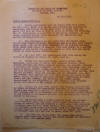
|
1.
October 30, 1927.
"Weekly Memorandum No. 1," Capt. R. W. Peard,
Commanding Officer, Ocotal, p. 1.
"OFFICE OF THE DIVISION COMMANDER ¶
DIVISION OF NUEVA SEGOVIA ¶ OCOTAL, NIC. ¶ 30
OCT 1927. ¶ WEEKLY MEMORANDUM NO. 1: ¶ 1. Weekly
memorandums will be issued from this office in
the future, which will embody instructions and
information concerning occurrences of the past
week, in order that all posts will have an idea
of what is going on within the Division, for the
intelligent co-operation of all posts, without,
in many cases, specific orders being necessary
for operations and matters of administration. ¶
2. The undersigned is now commanding all Marine
Corps forces from Jicaro to Esteli inclusive,
and on 1 Nov. will relieve Major Hayes, G.N. as
Division Commander of the Guardia Nacional.
Major Hayes will return to Managua. This will
result in a unified command of all marine and
guardia troops in this area and should result in
their maximum effectiveness. ¶ 3. On 1 Nov 1927,
the undersigned will also assume the duties of
Director of Police for Nueva Segovia. ¶ 4.
During the past week Lieut. Gould’s patrol from
Matagalpa, consisting of twenty five enlisted
marines, three guardia officers and forty
enlisted guardia, all mounted, effected a
junction with Lieut. Chappell’s patrol from this
area, near the scene of Lieut. Thomas’ crash,
about six miles north of Quilali, and this
combined patrol of two marine officers, fifty
marines, four guardia officers, fifty six
guardia, and Dr. Townsend, U.S. Navy, all
mounted, will operate for a few days around the
scene of the crash, with a mission of procuring
definite information of Lieut. Thomas and Sgt.
Dowdell, and defeating all bandit groups
encountered; at the completion of this mission,
this combined patrol will revert to the command
of the undersigned. ¶ 5. During the past week,
planes from Managua operated out of Ocotal on
combat and observation missions, in conjunction
with Gould’s and Chappell’s patrols; by bombing
and ground strafing with machine guns it is
believed that they inflicted serious losses on
the bandits in and around Quilali, with
corresponding loss of morale to the enemy. ¶ 6.
On 27 Oct 1927, a bandit group of about two
hundred under Jose Leon Diaz, with Simon Jiron,
alias “Pichingo”, as second in command, met and
defeated a bandit gang under Anastacio
Hernandez, near Dipilto, Nueva Segovia. This
battle resulted in the Hernandez group being
practically wiped out, Hernandez himself
escaping, but is [his] jefe Jose Torres
[Torrez?] was killed. Two members of Hernandez
gang were captured in Ocotal after the fight. ¶
7. The next day, 28 Oct 1927, two planes from
Ocotal, dropped seven bombs near Dipilto and
ground strafed the victorious band of Diaz, with
machine guns. [...]"
|
|
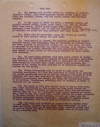
|
2.
October 30, 1927.
"Weekly Memorandum No. 1," Capt. R. W. Peard,
Commanding Officer, Ocotal, p. 2.
"[...] Page two. ¶ 8. The marines and
guardia under Lt. Keimling at Pataste, (Mosher’s
Ranch), last week captured twelve native rifles
from along the Honduras border, but the bandit
leader Jose Martinez escaped. ¶ 9. On the night
of 28-29 Oct 1927, a combined marine and guardia
mounted patrol, under Major Hayes, G.N. and Lt.
Claude, USMC. from Ocotal, raided bandit camps
near Sabana Grande, capturing three bandits, all
of whom are believed to be sub-jefes of Sandino.
One rifle and many machetes were also taken.
[“Also one fat turkey!” is handwritten here] ¶
10. There were NO casualties among the marine or
guardia forces of this command during the past
week. ¶ 11. Upon arrival at Jicaro, the enlisted
marines of Gould’s original patrol from
Matagalpa, will be available as replacements,
for sick, injured or unsuitable marines now in
this area, who will be returned to the rear with
Lt. Gould’s patrol, as it circles back to
Matagalpa via Esteli. Requests for such
replacements will be made direct to this office
by commanding officers of posts within this
Division. ¶ 12. All commanding officers will
make every effort to instil [instill] the spirit
of the offensive in members of their commands,
consistent with security, and no opportunity
will be neglected for patroling [patrolling]
when chances of contacts with bandit groups
seems assured. The mission of all troops in this
Division is to eliminate bandits and restore law
and order. ¶ 13. Native information will be
acted on only under the following conditions:
(1) When the informant is known to be reliable
and states positively that he or she has
personal knowledge of facts reported; (2) When
such informant or other reliable guide can be
procured to accompany our troops, who knows the
country and trails to be covered. Promiscuous
patroling [patrolling] will be avoided, in order
to conserve men and mounts. ¶ 14. The roads in
this area should begin to dry up very soon, and
a geat [great?] improvement in this matter has
been noted during the past week, streams
returning to normal size. This, and the expected
arrival from the U.S. of a tri-motor cargo
plane, capable of carrying a load of one and a
half tons, should improve our rations situation
in the near future. In the meantime, we must get
along with the somewhat unbalanced rations
available, augmented by maximum amount of local
purchases, that can be made at reasonable
prices. ¶ 15. All posts must overlook no
opportunity to improve their landing fields, and
keep them in first class condition. At posts
where no landing field is in operation, every
possible effort must be made to locate and clear
a suitable field, even if it will only do for
emergency use. [...]"
|
|
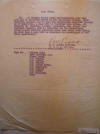
|
3.
October 30, 1927.
"Weekly Memorandum No. 1," Capt. R. W. Peard,
Commanding Officer, Ocotal, p. 3.
"[...] Page three. ¶ 16. All routine Marine
Corps correspondence from this area may be
forwarded direct to the Commanding Officer,
Fifth Regiment, Managua, and in case the
information contained therein is of importance,
a copy will be furnished this office. All
requests for supplies, rations, equipment, etc.
except Post Exchange Supplies, will be forwarded
via the undersigned, unless urgent military
necessity makes such delay inadvisable, in which
case a copy will be furnished the undersigned at
the first opportunity. ¶ R. W. PEARD, CAPTAIN, ¶
U. S. M. C. and G.N. ¶ COMMANDING. ¶ Copy to:
Brigade Cmdr. ¶ Jefe Director, G.N. ¶ Lieut.
Gould. ¶ C.O. Jicaro. ¶ C.O. Ocotal. ¶ C.O.
Somoto. ¶ C.O. Pueblo Nuevo. ¶ C.O. Telpaneca. ¶
C.O. Pataste ¶ C.O. Esteli ¶ C.O. Matagalpa ¶
File."
|
|
NEXT PAGE
|
|
|
|


